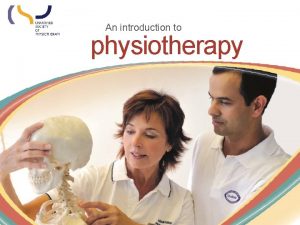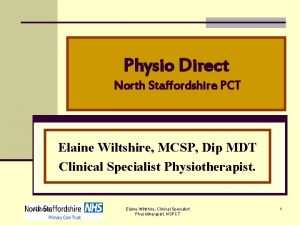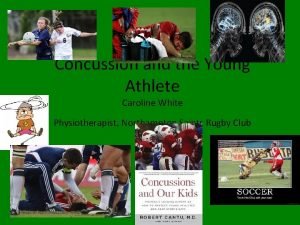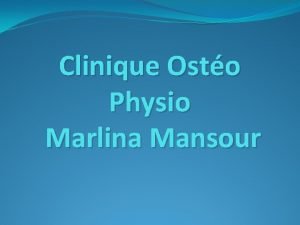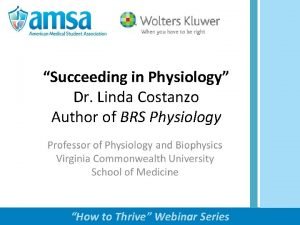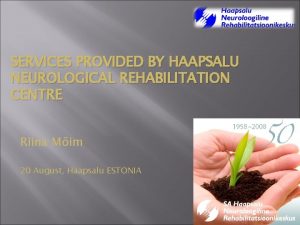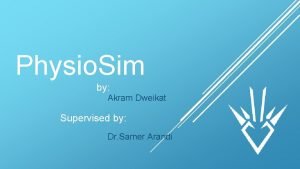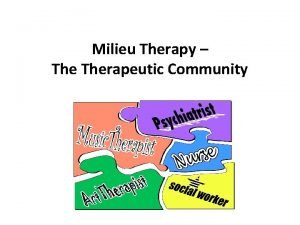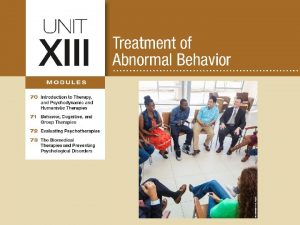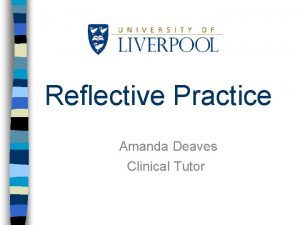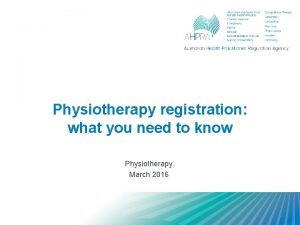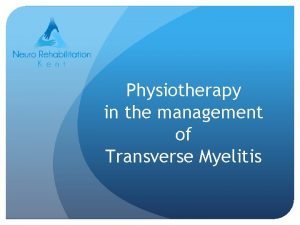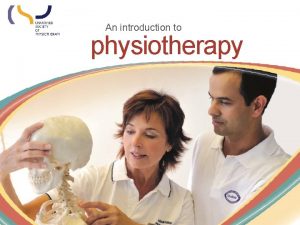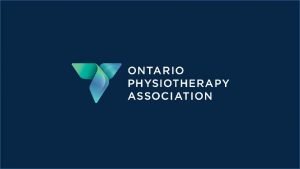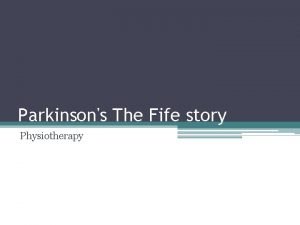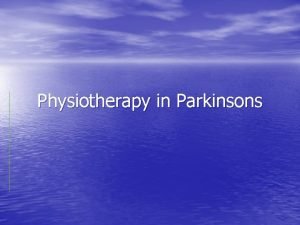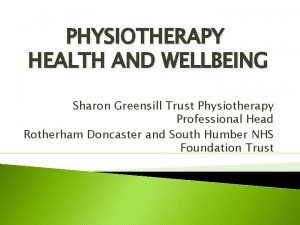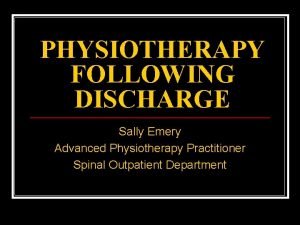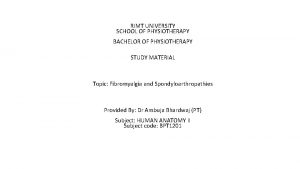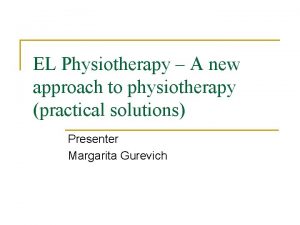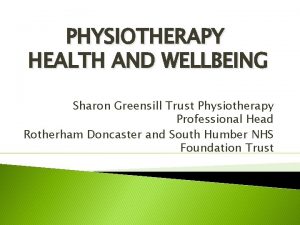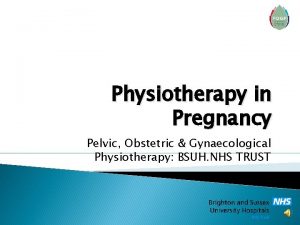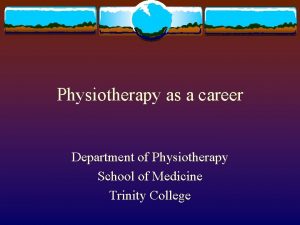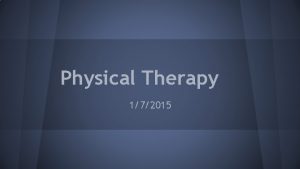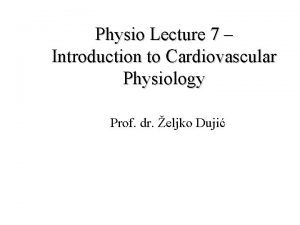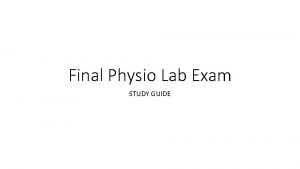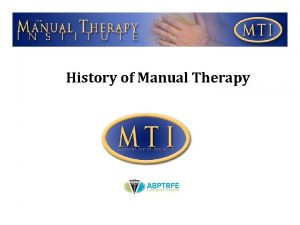Introduction to physiotherapy PHYSIOTHERAPY PHYSICAL THERAPY Physio physical

























- Slides: 25

Introduction to physiotherapy

PHYSIOTHERAPY PHYSICAL THERAPY Physio : physical agents Therapy : treating people

Physical Therapy n therapy for the preservation, enhancement, or restoration of movement and physical function impaired or threatened by disability, injury, or disease that utilizes therapeutic exercise, physical modalities (as massage and electrotherapy), assistive devices, and patient education and training—called also physiotherapy n Merriam-Webster’s definition

Physiotherapy is…. . A primary health care profession n Aimed at enhancing mobility, physical independence & quality of life n Focused on Treating a variety of conditions Promoting health & well-being n Prescribed to individuals who vary in Age Athletic ability n

What does a physiotherapist do? Diagnose Make decisions on the presenting problem n Treat Using education, exercise, electrotherapy, manual therapy n Rehabilitate To achieve the best functional level n

Who are physiotherapists? n Go-to health professionals Accessible, first-line health professionals n Skilled in health promotion, injury prevention and patient management n n University-trained in the health sciences n Intensive study of anatomy and physiology

Who are physiotherapists? n Skilled in clinical reasoning Life long learners n Committed to evidence-based decision making n n Licensed and regulated health professionals with a unique professional title n Only registered physiotherapists can provide physiotherapy services

What exactly do physiotherapists do? Assess, manage and treat a broad range of medical conditions from sprained ankles to strokes Relieve physical pain and help heal injuries Increase mobility, build strength, improve balance, and enhance cardiovascular

n Help you to help yourself n Engage clients by prescribing therapeutic exercises n Teach clients to better manage their own health

Different work settings Hospitals n Rehabilitation centers n Private clinics n Home visits n Sport fields n Community based centers n

Different clients Paediatrics n Geriatrics n Athletes n Regular adult population n Patients n

Branches of physical therapy Neurology n Orthopaedics n Musculoskeletal conditions n Cardio respiratory n Community base rehabilitation n Women’s health n

What conditions do physiotherapists treat? n n Neurological n Developmental delay n Parkinson’s disease n Spinal cord injury n Stroke Benefits n Improved balance, coordination, strength, flexibility, and function n Ability to manage daily tasks n Reduced pain n Improved mood

What specific conditions do physiotherapists treat? n Orthopaedic n Back and neck pain n Arthritis and osteoarthritis n Fractures or sprains n Joint replacements n Sports injuries n Benefits n Decreased pain n Improved joint mobility and strength n Restored physical function and injury prevention n Possibly prevent or delay

n Cardio-respiratory n Chronic obstructive pulmonary disease n Cystic fibrosis n Heart disease n Respiratory infections n Post-surgical care n Benefits n Improved breathing and secretion clearance n Reduced breathlessness and increased endurance n Increased strength of arms and legs

n Women’s health n Breast cancer rehabilitation n Chronic pelvic pain n Incontinence n Benefits n Reduced post-surgical pain and swelling n Reduced fatigue caused by radiation and chemotherapy n Improved pelvic pain and urinary incontinence

Treatments n Electrotherapy n Exercises n Hydrotherapy / Aquatherapy n Posture & ergonomic corrections n Chest physiotherapy techniques

Electrotherapy IR n SWD n MWD n Electrical Stimulation n Wax Therapy n

Exercises Passive exercises n Stretching exercises n Strengthening exercises n Mobilizing exercises n Breathing exercises n

Hydrotherapy / Aquatherapy

Posture & ergonomic corrections

Chest physiotherapy techniques

Your future Bachelor of Physiotherapy n Masters of Physiotherapy n Doctor of Physiotherapy n

Any questions

Thank you
 Disadvantages of suspension therapy in physiotherapy
Disadvantages of suspension therapy in physiotherapy Introduction of physiotherapy
Introduction of physiotherapy Introduction of physiotherapy
Introduction of physiotherapy Physio direct northallerton
Physio direct northallerton Caroline white physio
Caroline white physio Physio pleasure examples
Physio pleasure examples Physio-pleasure
Physio-pleasure Jane ann meehan
Jane ann meehan Varilux panamic
Varilux panamic Chris perkins physio
Chris perkins physio Marlina mansour
Marlina mansour Triangle physiotherapy king west
Triangle physiotherapy king west Linda constanzo
Linda constanzo Villa fridheim haapsalu
Villa fridheim haapsalu Sim physio
Sim physio Physio toolbox
Physio toolbox Psychodynamic and humanistic therapies have in common
Psychodynamic and humanistic therapies have in common Bioness integrated therapy system occupational therapy
Bioness integrated therapy system occupational therapy Humanistic therapy aims to
Humanistic therapy aims to Role of nurse in group therapy
Role of nurse in group therapy Dr carlson advises his depressed patients
Dr carlson advises his depressed patients Solent physiotherapy
Solent physiotherapy Gibbs reflective cycle example physiotherapy
Gibbs reflective cycle example physiotherapy Physiotherapy registration requirements
Physiotherapy registration requirements Transverse myelitis physiotherapy
Transverse myelitis physiotherapy Physiotherapy degree apprenticeship
Physiotherapy degree apprenticeship


